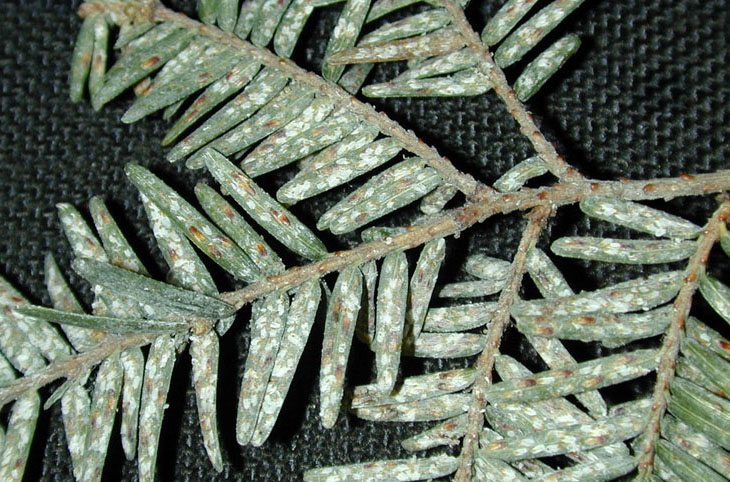Wisconsin issues quarantine for elongated hemlock scale that includes Michigan
Quarantine will impact Michigan growers who will need to implement additional steps to ensure compliance.

On July 1, 2023, the Wisconsin Department of Agriculture, Trade, and Consumer Protection (DATCP) issued an exterior quarantine to prevent the introduction of elongated hemlock scale into that state. This quarantine includes Michigan, along with many states along the eastern United States where elongated hemlock scale has been previously found. Any Michigan business that ships regulated articles, including Christmas trees, nursery stock, branches and wreaths, into Wisconsin must comply with this quarantine. Some common questions regarding elongated hemlock scale and the new Wisconsin quarantine are listed below.
Can I still sell products into Wisconsin?
Yes, Michigan tree growers can ship tree products into Wisconsin if they follow quarantine requirements. There are two ways to qualify for this regulation. First, if the importing business in Wisconsin has entered a compliance agreement with DATCP, growers in Michigan may receive a request for certificate stating that the products have been found free from elongated hemlock scale life stages. Check with the company you are selling to and see if they have a compliance agreement. If the firm is not under a compliance agreement with DATCP, Michigan growers will need to be proactive in obtaining a certificate certifying they are free of elongated hemlock scale. Check with the Michigan Department of Agriculture and Rural Development (MDARD) to determine the specifics of obtaining a certificate. If elongated hemlock scale is found on the products, a treatment is required followed by an additional inspection to confirm the success of the treatment.
What is elongated hemlock scale?
Elongated hemlock scale (Fiorinia externa, Photo 1) is an insect pest native to Asia that was first reported in New York in 1908. From that point it has gradually spread along the east coast, into Michigan and as far south as Georgia. It has not yet been established in other areas of the country (Wisconsin, for example). It prefers to feed on hemlock trees, but will sometimes colonize and develop on other conifers, such as firs, spruces and to a lesser extent pines and Douglas fir.
What damage does elongated hemlock scale cause?
Elongated hemlock scale sucks sap from tree needles. Light infestations may be unnoticeable but moderate to high densities. Elongated hemlock scale may cause needles to be shorter, grayish or yellowish and slow growth of young trees. White or tan colored wax on needles is produced by the male elongated hemlock scale as they mature. These deposits may cause Christmas trees to be unsaleable (Photo 2).

How widespread is elongated hemlock scale in Michigan?
In Michigan, elongated hemlock scale is generally a minor pest that is rarely found on Christmas trees. It often co-occurs with hemlock woolly adelgid (Adelges tsugae), a sap-feeding insect that has killed thousands of eastern hemlocks. In Christmas tree growing regions of North Carolina, elongated hemlock scale has become a widespread pest.
What is the lifecycle of elongated hemlock scale and do treatment options exist?
Elongate hemlock scale is an armored scale. Individual insects are well protected within the hard waxy covering they secrete around themselves as they feed. Each female may lay 12-16 eggs within the waxy coating. Once eggs hatch, the tiny crawlers (first stage nymphs) move about on their tiny legs to find a suitable feeding site. Crawlers may stay on the same needle they hatched on, move to new growth on the same tree, or be passively carried by wind or animals to a new location. Once a crawler settles and inserts its mouthparts into a needle to feed, it will molt and lose its legs. These scales do not excrete honeydew but do secrete the white wax covering from pores in their body. Females elongated hemlock scale will remain attached to the needle for the remainder of their life. Mature males have wings and will fly to females for mating. At high densities, there can be as many as 30 elongated hemlock scale on a single needle.
Elongated hemlock scale can be a very challenging pest to control. Like other armored scales (e.g., pine needle scale; oystershell scale), the hard waxy coating protects insects from contact insecticides. Crawlers do not have the waxy protective covering and will be vulnerable to cover sprays of insecticides or horticultural oil. However, crawler development is not well-synchronized and crawlers can be active throughout the season. Michigan State University Extension recommends scouting trees to assess whether crawlers are present and their relative densities. Many crawlers will be hatching between late May and early June, but this can vary considerably. Insecticide products labeled for elongated hemlock scale are listed in the Michigan Christmas Tree Pest Management Guide. Finally, because most elongated hemlock scale will be on the underside of needles, thorough spray coverage is critical.
Elongated hemlock scale do not feed on vascular tissue within shoots, which reduces the effectiveness of the common systemic insecticide imidacloprid. However, dinotefuran, another systemic insecticide, is effective at controlling elongated hemlock scale. Dinotefuran is much more soluble in water and will move through the xylem of the plant into the needles where elongated hemlock scale feed. Dinotefuran can be applied as a basal trunk spray, as a soil drench or injected into the base of trees. It can take several weeks or even months for dinotefuran products to move up the trunk and into shoots and needles of conifers, including hemlocks.
There are other cultural control options for elongated hemlock scale. Because elongated hemlock scale do not move widely, culling highly infested trees may reduce populations. Also, think about whether infested hemlock trees are near Christmas tree fields. Many beneficial predators and some tiny parasitoid wasps will feed on elongated hemlock scale. Promote these insects by reducing or eliminating the application of broad-spectrum insecticides, which often cause significant damage to natural enemy populations.



 Print
Print Email
Email



